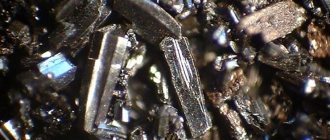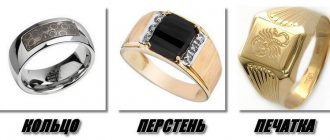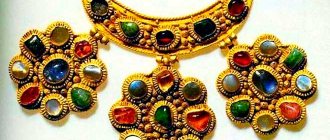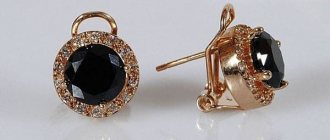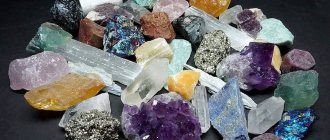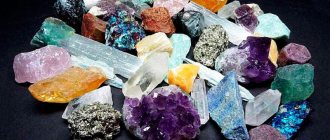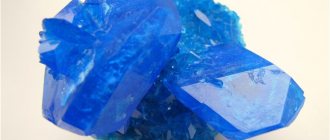Post updated: May 26, 2020
Coins and other gold products in Russia have always been and remain at the present time not only objects of pride, but also guarantors of economic stability. The extraction of this metal is the most important indicator of the level of development and strength of the country’s domestic market. The level can be determined by stock price indicators. The cost of gold does not stand still - it is formed by the number of deposits being developed; the higher the level of gold mining, the cheaper the sale.
Historical background on gold mining in Russia
Active gold production in Russia began to appear in the eighteenth century. There is no exact information, but it is believed that this is due to the fact that a pebble of this precious metal was allegedly found in the Yekaterinburg region by a certain schismatic. Historians claim that the person who found the first gold nugget subsequently continued to search for the same pebbles, which made it possible to find enough of them to establish a real mine. The name of the mine turned out to be quite expected: “Primary”.
The first records and mentions of the presence of gold can be found in the documents of scientific researchers. Judging by them, the first finds of gold date back to the fifth century AD. Accumulations of precious metal in the territory were observed in the Ural mountains. Evidence is provided by archaeological finds - rings and other jewelry, partly utensils and objects for economic and cultural purposes.
The gold of the Russian Empire was a special source of pride, as it served not just an economic purpose, but also a cultural one - people came from different cities and countries to look at the works of jewelers, which increased the prestige of the state in the eyes of the rulers of other states. Active development of gold deposits, and therefore the search for this metal, began after a corresponding decree issued in 1719 by Peter the Great. Less than a hundred years have passed since gold miners in Russia, among whom, first of all, were ordinary miners, brought the country to a leading position in terms of mining and processing of this sparkling metal.
Gradual development of the industry
Gold was seen not only as other minerals in Russia, but also as a source of economic stability, so the best scientific minds of their time worked to improve existing methods for extracting the metal and develop new ones. In the nineteenth century, the Urals became the basis for gold mining, and with it the western part of Siberia. During this period, the first minted coin made from gold appeared. Further reforms allowed foreign citizens to work in the mines, which caused an increase in gold exports from Russia. Today there are more than eight hundred explored and developed deposits in our country.
How Romanian valuables were returned
The main condition for the transfer of values was the return of Bessarabia to the Soviet Union and the repayment of debts for the property of the Russian army abandoned and plundered on the territory of Romania and Bessarabia.
In 1935, trying to build a system of “collective security” in Europe and moving closer to France, the Soviet government restored diplomatic relations with French ally Romania, without yet demanding concessions on Bessarabia. As a sign of goodwill, the USSR leadership sent 1,436 (17 wagons) of 3,469 boxes in which Romanian valuables were transported to Tsarist Russia to Bucharest. The Romanians could hardly be satisfied with this gesture - the restitution included mainly archival documents and other papers of undoubted interest to the country. But in historical rather than material terms, Moscow was in no hurry to return true valuables in the form of gold and jewelry: only 12 tons of gold were sent. The USSR promised to return the entire Romanian gold reserve with the “final settlement of the Bessarabian issue.” However, when in the summer of 1940, under the threat of a Soviet military invasion, Romania agreed to give the required lands to the Soviet Union, it never received gold in return due to the fact that it agreed to transfer the territories not voluntarily, but under pressure. According to the Paris Peace Treaty of the Allied Powers of 1947, Romania, as a former ally of Hitler's Germany, had to pay the USSR $300 million in reparations - a fifth of the real damage caused by Romanian troops to our country, officially recognized by both Romania and the USSR's allies. In the fall of 1948, Stalin, for humanitarian reasons (drought, mass famine, industrial devastation, growing unemployment, Romanian-Hungarian conflicts in Transylvania) and the desire to strengthen the Romanian government controlled by the USSR, reduced the remaining payments ($ 220 million) by two thirds, and by in the spring of 1949, they were completely annulled in exchange for the establishment of a “people’s democracy” regime in Romania. According to the materials of the Allied Control Commission in Romania from representatives of the USSR, Great Britain, and the USA (1944–1948), with the consent of the allies, 65–80% of the Romanian annual reparation payments were offset by the royal gold reserves. In 1949 Stalin ordered part of the gold reserves - about 30 tons - to be transferred to the holdings of the new, socialist Romanian government.
In 1956, N. Khrushchev sent another batch of Romanian valuables to Bucharest - 4 tons of gold and all historical and artistic valuables from Romanian museums - 39,320 items, including coins, medals, jewelry, icons, church utensils, paintings and drawings. In 1964, on the instructions of L. Brezhnev, the Romanians received another 8 tons of gold. The total volume of returned Romanian gold was 54 tons, all other treasures were returned, and Romania's war reparations debts were forgiven. Nevertheless, in 1965, the Romanian communist leader N. Ceausescu proposed to L. Brezhnev to give away approximately 93 tons of Romanian gold remaining in the Soviet Union (according to his calculations), but in response he heard that Romania’s debts accumulated within the framework of the Warsaw Pact significantly exceeded the value of the despised metal. The USSR's reluctance to consider this issue became a stumbling block in Soviet-Romanian relations, which were the most tense within the bloc of pro-Soviet states in Europe. As the Accounts Chamber of the Russian Federation established, based on data from a number of archives of the USSR and Romania, in 1986 Bucharest received another 10 tons of gold; this “payment,” sent “quietly,” was associated with M. Gorbachev’s hope for an end to Bucharest’s harsh criticism of the notorious perestroika. But this did not happen.
As a result, the Soviet Union returned to the Romanians the entire gold reserve of the Romanian National Bank - 64 tons of gold and all other Romanian treasures.
| 1900 | 1905 | 1910 | 1913 | 1915 | 1920 | 1925 | 1930 | 1935 | 1940 |
| 10,57 | 22,57 | 34,85 | 43,94 | 64,1 | 1,96 | 72,98 | 84 | 97 | 139,88 |
Table 1.
Gold of the Romanian National Bank (according to World Gold Council)
The current state of affairs in the gold mining industry
Currently, Russia has reduced its influence in terms of production rates, falling 3 steps down - now the country ranks only sixth in the world. However, as before, more than half of all gold reserves are concentrated in Siberia. The main deposits are located:
- In the Far East;
- In Siberia;
- In Yakutia;
- In Buryatia.
The main mines producing gold are:
- Solovyovsky;
- Udereysky;
- Nevyanovsky;
- Altaic.
It is interesting that Solovyovsky is the oldest of the currently operating mines. Udereisky, on the contrary, is the youngest mine. Metal mining is carried out there not constantly, but in periods. The gold of the Russian Empire was highly valued at all times, so the enterprises were at that time the property of the tsarist government, and later became the pride of the state and the basis of its economic power.
"Solovyovsky" mine.
Gold production at the end of the 20th century was surprisingly high. The Conder mine, which was founded in the late 1960s, was then and is today a major site for mining the yellow metal. Over the entire period, gold producers working on it produced about one hundred and fifty tons of this metal, which is a kind of record in Russia. Today the mine also allows for platinum mining.
Who owned the Romanian gold?
As political scientist D. Dumitriu explained, the gold sent to Russia did not belong to the Romanian state. The documents signed by representatives of Romania and the Russian Empire state: “the gold reserve is the private property of the National Bank of Romania.” At the time of its establishment, in 1880, the state share was 30%, and private capital - 70%. In 1900, the National Bank of Romania no longer belonged to the state, as it sold its share. Therefore, the Romanian gold reserve did not belong to either the Romanian people or the Romanian state, but was the property of wealthy oligarch shareholders.
Gold as an indicator of the importance of the state
A country’s place in the ranking of influential, wealthy and economically strong countries is determined, among other things, by the volumes it can produce in the minerals segment. Thus, according to statistics, Russian gold is mined at a rate of 250 tons per year, which allows the country to occupy a place in the top ten in the ranking of gold mining countries. The largest increase in production can be seen in the northern regions, in particular in Chukotka, where production levels increased by forty-six percent compared to 2013 levels. Judging by the reports of specialists in this field, the volumes are only increasing every year - annually the figures increase by about a quarter.
Gold mining industry in the 50-70s
After the war, the industry was transferred to the management of Glavspetsvetmet, formed on the basis of Glavzoloto. This organization was a structure of the Ministry of Internal Affairs, which employed the labor of convicts in correctional institutions. Only in the Gulag system after the war, about 30 large structures functioned, purposefully engaged in gold mining. In 1947, the charter of artels operating in the Glavspetsvetmet system was issued. The exploitation of essentially free prison labor and certain other rational methods brought results. In 1950, production was 100 tons, and three years later, the state’s gold volumes reached an unprecedented amount - 2049 tons.
Under Khrushchev, the gold mining sector was reformed, which had a bad effect on its performance. The plans were not fulfilled, despite the discovery of new mines (in particular, in 1961 the Sukhoi Log deposit was discovered in the Lensky gold mining region). The quality of production management left much to be desired. However, in 1965, the newly formed Glavzoloto was introduced into the newly created Ministry of Non-Ferrous Metallurgy. Over the first ten years of operation, the percentage of integration of technical equipment increased; this action gained momentum after the introduction of cost accounting. Enterprises were allowed to keep a percentage of their earnings to increase production and purchase equipment.
From 1966 to 1975, the volume of production in gold mines only grew, reaching more than 280 tons.
Gold mining methods
Monetary and jewelry gold in Russia is mined in different ways. They change and improve over many hundreds of years. For the first time, precious metal was processed at enterprises thanks to the manual labor of miners - they sifted sand with fossil particles using ordinary sand and water. Gradually, technology made it possible to extract gold directly from ore. Today this process is completely automated and mechanized, without making it any easier in terms of the labor intensity of the work and the responsibility of people.
Interesting Facts
Despite the significance and value of the metal, those deposits in which there are only three grams of gold per ton of mined rock are considered profitable, that is, payable. If its quantity for the same volume reaches ten grams, then such a deposit receives the status of rich.
One of the extraction methods, called amalgamation, is also interesting. The essence of the method is to place mercury at the bottom of a specially prepared barrel, into which the mined gold-bearing rock is added. As a result of manipulations and chemical processes performed by people, gold particles are separated from the bulk of the ore and stick to the bottom of the container. Today they try not to practice this method, since it is very toxic and dangerous to human health due to mercury vapor.
Nowadays, gold is extracted from rock ore using a new method, using a chemical compound called sodium cyanide. This substance has the unique ability to convert even the smallest and invisible particles of gold into cyanide compounds that dissolve in water. The method helped not only to increase production volumes, but also to return to the development of deposits that were considered unprofitable, abandoned due to the small amount of precious metal that could be obtained by other methods.
Gold is mined using "floating" mining machines, which are specially equipped for this purpose to extract gold from the ground. The method has proven itself well and is actively used in Russia.
Where was the first Russian gold mined?
Europe had little of its own gold. Although we tried and searched. During these searches, a rich deposit of silver was found in the Kutná Hora region in Bohemia. But gold appeared in significant quantities in Europe only in the 16th century, when Spanish conquistadors began to plunder the South American empires of the Mayans, Incas and Aztecs.
In Russia there was the same picture. Over the entire centuries-old history of both Kievan and Moscow Rus', no gold ore was discovered on its vast territory. So both the gold and the precious stones on the Armory Chamber’s treasures are imported. Brought mainly from Byzantium. And the main currency in the Moscow state was sable skins and silver “efimkas” (“joachimstallers”) from the same Bohemia.
But in Russia they searched for gold with no less lust than in Europe! For this purpose, Ivan III ordered ore miners from Italy. His grandson, Ivan the Terrible, sent Ermak to conquer Siberia so that he would have something to increase his wealth. Wealth, of course, grew, but gold was found in Siberia only under Peter I, who recruited many German scientists to search for valuable metals and minerals and founded the Bergkollegium, that is, the Ministry of Mining Affairs.
Investments in the development of Siberia and the Urals were not in vain. Even during the life of Peter I, in 1714, at the Nerchinsky mines in Transbaikalia, where silver was then mined, the worker Ivan Mokeev began to mine gold by washing mine dumps. From the “wild steppes of Transbaikalia” this method “moved” to the Altai silver mines in Kolyvan, which belonged to Akinfiy Demidov. But still, washing the dumps of silver and copper mines to extract gold from them on an industrial scale was unprofitable.
“Real” gold mines were discovered in the mid-18th century in the Urals in the city of Berezovsky, 12 km from Yekaterinburg. But nevertheless, the first Russian gold was mined on an industrial scale not in the distant Urals, but in areas much closer to St. Petersburg, in Karelia .
In this delightfully wild and almost deserted region lies the picturesque Vygozero. Twenty-five rivers flow into this lake, and only one flows out and flows into the White Sea - Nizhny Vyg. There were many rapids and waterfalls on this river. The most famous among them is Voitsky Padun. The water here fell along three branches from a height of more than 4 meters, emitting a terrible roar and howl. This is where the name of the waterfall came from - Voitsky.
In the 16th century, the village of Nadvoitsy appeared just above the waterfall (above the Voitsky waterfall!). It belonged to the Solovetsky Monastery. Like almost all the villages in these parts, Nadvoitsy was a sparsely populated village. In 1647, there were 26 peasant households and a church. Therefore, 100-150 people lived in Nadvoitsy.
It is problematic to feed yourself by farming in these parts. Therefore, many earned money through mining. In the local forests it was possible, if you were lucky, to “dig” copper ore, which the peasants handed over to the neighboring Vygovsky monastery. In their own metalworking workshop, the monks cast crosses and small icons.
In 1737, one of these amateur miners, Taras Antonov, found a copper vein not far from Nadvoitsy. The ore found turned out to be quite rich, and they began to develop it industrially. This is how the Voitsky mine was opened. The copper ore that was mined here was now sent to Petrozavodsk, to the sovereign copper foundry. Copper ingots smelted from Voitsk ore were transported from Petrozavodsk to the Mint in St. Petersburg, where coins were minted: half rubles, kopecks and nickels.
It turned out that it was not for nothing that Peter I was so concerned about having competent mining engineers in his empire. One of them noticed that some yellow shiny grains sometimes sparkled in the ore from Nadvoitsy. Gold! Thus, for the first time in Russia, precious metal mining began at the Voitsky mine. Over 50 years of work, the Russian treasury received from here about 74 kilograms of gold and more than 100 tons of copper. But then the mine became depleted and was closed. However, they say that the local population is still quietly panning for gold.
As we can see, the “golden age” of Nadvoits was short. It would seem that the village will now fall into oblivion forever. But in 1916, the Murmansk Railway passed through here and a railway station appeared. The railroad workers were serious about gradually developing the wild land around the railroad. Under the management of the Murmansk Railway, a transport and industrial colonization plant was even organized for this purpose. One of the results of the work of this unit is a village built near Nadvoitsy with the somewhat strange name “Red Colonist”. Although, if you think about it, everything is clear. “Red”, what other favorite color was in the country of the Soviets in 1925? “Colonist” clearly designates the department that claims to become the owner of these places.
However, at the end of the 1920s, another department became the owner here. The White Sea Canal route, one of the first Gulag construction projects, passed through Nadvoitsy. Of the 140 thousand prisoners who worked (and died) on the canal, about 20 thousand people lived in the camps around Nadvoitsy. On the streets of the village, a security officer in a cap with a blue band and a leather coat became an ordinary passerby. However, the fate of the “camp capital”, like Dmitrov near Moscow, Nadvoitsa has passed. Although there is still a “zone” in Nadvoitsy.
Moreover, the village became a refuge from periodic purges of the “hostile element” for many residents of Leningrad. These people quite reasonably decided that it was better for the leaf to hide in the forest, and they left for the camp areas themselves, without waiting for them to be sent here under escort. Nadvoitsy was all the more suitable as a place of voluntary exile because Leningrad could be reached from here by train in less than a day.
Because of this, in the late 1930s and 1940s the average educational level of the population of Nadvoitsy was unusually high. So, when in 1948 it was decided to build a large aluminum plant in the village, there were apparently no problems with recruiting personnel.
Tags: Karelia, gold, north, Russia, interesting fact, history, precious metals
What you need to know about gold
The shine of bullion attracts people's attention, so many questions arise regarding gold, the answers to which are important to know. Translated from ancient languages, the name of the metal means “bright”. It is found in varying quantities on all known continents. It is an excellent conductor of heat and electricity. It is impossible to see gold damaged by corrosion processes - it does not rust, and therefore is so highly valued among jewelers. It also does not cause allergic reactions or skin irritations, so it is available to all people. If an allergy manifests itself, this means that the person in front of him is not pure metal, but an alloy.
Despite the active development of deposits discovered by people throughout time, according to experts, almost 80% of the metal never saw the light of day, since it is located deep in the bowels of the planet. At the same time, it has been decided to reduce the volume of gold exports from Russia today.
The jewel is also actively used in medicine, as studies have shown its effectiveness in the treatment of rheumatic diseases. In Middle Eastern countries, gold dust is added to drinks, for example, to coffee in expensive hotels or restaurants, the reason is the edibility of this metal. Some Indian tribes sincerely believed that eating it gives a person the ability to fly without special devices, that is, it opens up the possibility of levitation.
Economic crises and other financial shocks affect gold the least, so investors tend to invest in this metal. The maximum price of gold was recorded at $1,000/ounce in 2008.
The largest ingot in history was produced with a total weight of 200 kg. Modern high-tech giants, according to a study conducted several years ago, have the value of their shares equal to gold.
The most coveted award for an athlete, a gold medal, in the modern world is only a gilded likeness of the previous medal, cast entirely from the most valuable metal. On average, no more than 6 grams of yellow metal are spent on coating.
In ancient times, the Incas believed that gold was a gift from the gods. At that time, gold jewelry had not only aesthetic, but also religious significance, but at the same time they had no financial power at all. The Egyptians mined gold by sifting out its sand using sheepskin. This is probably where the legend of the “Golden Fleece” originates.
Gold in ancient times was considered part of divine power. In Egypt, it was equated to the flesh of the god Ra, so only pharaohs and clergy - priests had access to the metal. Nubia was considered the leader in production in those days.
The famous story about the golden calf today does not find sufficient evidence of its truth, and therefore scientists consider it a fiction. The reason for this is the fact that gold in those days was not yet in any way connected with money and financial calculations, therefore no one would have thought of bribing the gods with a golden calf. However, the Bible mentions gold in one form or another at least 400 times. Among other things, there is an instruction from God to cover the furniture in the tabernacle with this metal. It also acts as one of the Gifts presented by the Magi.
Gold-bearing rivers of Russia
The Russian Federation has many water structures in which gold can be panned.
| Reservoirs | Characteristics |
| Sanarka River. | Two centuries ago it was considered a rich deposit of minerals and precious materials. Now the area of Sanarka is partially gold-bearing. |
| Lena River basin. | One of the richest reservoirs in the Russian Federation. There is still a lot of gold left in already mined deposits, which, however, is no longer suitable for industrial mining. |
| Bodayo River. | The alluvial yellow metal of this river is mostly large: from 2 to 4 mm. In some places there are also nuggets. |
| Big Chanchik River. | There are sometimes finds weighing several kilograms. |
| River Bom. | Suitable for mining absolutely throughout its territory. It's worth looking for gold there: it may lie in the crevices between shale rocks. It often happens that the amount of material accumulated in such “caves” reaches one and a half kg. |
| Alekseevsky stream. | The gold there is large and well rolled. The nuggets weigh up to a kilogram. |
In the Jalon stream, the surface of the gold-bearing layer shone after the rains washed away the sand and thus was easy to distinguish at first glance. Palm-sized nuggets can easily be found in the Talga River even today. In the Unakha River, precious metal was collected using trays and scooped out from ferries with ladles.
Millionny Brook is famous for the fact that the placer itself was found here by accident. In 1896, a pack horse belonging to a group of smugglers fell into a ravine. When they began to pull the animal out, nuggets were found at the bottom of the stream. The placer turned out to be incredibly rich: more than 640 kg were obtained in a month.
Instead of an afterword
The increasing import of gold from foreign countries to Russia is caused by an increase in consumer demand, since it is here that the most valuable jewelry is produced, turning lifeless metal into a work of art. Research allows you to increase volumes, which makes it possible to establish profitable trading. This, in turn, will strengthen the economy not only of Russia itself, but also of all countries participating in transactions in the market of precious metals and products made from them. Every year, production volumes and methods are improved, allowing reserves to be replenished, thereby moving the financial situation into a positive direction, so today all attention should be directed to this industry.
Pre-war period.
0
In 1927, Glavzoloto was reorganized into Soyuzzoloto, and organizational measures were taken to create a geological exploration service and train new personnel. The first measure to stimulate mining was the development of a system of financing and encouraging private gold mining and small gold mining enterprises. In 1923, gold mining began in the Aldan River basin (Yakutia). They say that gold could be collected by hand. The main gold mining in the region was carried out by the Aldanzoloto trust. Over two years (1927-1928), production of the precious metal increased by 61%. In 1929, more than 25 tons of pure gold were mined in the country, most of it brought by government organizations. The next significant increase in the volume of gold produced occurred in 1936 and 1937 and amounted to 130 tons; Russia took second place in gold mining in the world ranking. By the beginning of the war, the fishery supplied the state treasury with about 174 tons of precious metal per year. Most of the reserves were used to purchase equipment for industry, ensuring the industrialization and independence of the USSR.
6.
Altai pyramid
In 1723, the major Ural industrialist Akinfiy Demidov sent his clerks Matvey Kudryavtsev, Leonty and Andrei Kabanov to the foothills of Altai, who soon discovered rich deposits of copper ores on the slopes of Mount Sinyukha, near Lake Kolyvanskoye and in other places.
In the spring of 1726, Demidov craftsmen, led by Dmitry Semyonov, conducted a trial smelting of copper ores on the banks of the Kolyvanka River (currently the Loktevka River). And in October 1727, under the leadership of Nikifor Kleopin, the Kolyvan Hand Factory was built. In fact, it was a small hut that housed a single furnace for smelting copper. And the copper-poor ore of the nearby Demidov deposit was processed there.
However, the manual wind did not work for long: it turned out that the river was low-water, its opening was too wide, and therefore inconvenient for installing a water-filling wheel. And the enterprise was moved to the Belaya River, to the neighboring village of Kolyvan of the present Kurinsky district.
And on the site of the first Demidov mine in Altai, 200 years later, the workers’ village of Kolyvanstroy appeared. Its inhabitants in the 1930-1950s mined tungsten - a refractory, heavy and very hard metal, which even experienced mining engineers simply did not know two centuries earlier.
Copper ore began to flow into Kolyvan from the Voskresensky deposit. That’s why the plant was called Kolyvano-Voskresensky. However, this was the name of not only the metallurgical enterprise, but for a long time also a huge administrative unit - the Kolyvano-Voskresensky mountain district, which included almost the entire modern Russian Altai, as well as vast territories of the Novosibirsk, Kemerovo, Tomsk and East Kazakhstan regions. And Kolyvan was the capital of Altai from 1725 to 1747, until the Office of the Kolyvan-Voskresensk factories moved to the village of the Barnaul plant.
The enterprise in Kolyvan consisted of a smelter with water-powered bellows for supplying air to the furnace, a roasting room, a gormakher for smelting pure copper, a saw mill, or water-powered sawmill, as well as a forge in which copper utensils were made. Ore was smelted using charcoal.
On the territory of the former Kolyvan-Voskresensky copper smelter, the Kolyvan stone-cutting plant has been located since 1802. And on the site of the manual factory, our contemporaries built a memorial sign in the form of a pyramid.
Gold mining companies in Russia.
0
The gold mining industry in Russia is well developed, which contributes to the constant emergence of new participants in the market. We are talking about gold mining companies, the number of which is constantly growing. The leader of the gold mining industry in Russia is OJSC Polyus Gold. The company is developing in the area of placer and ore deposits in the following regions: Irkutsk region (at the mouth of the Vitim River, Verninskoye, Zapadnoye, Chertovo Koryto deposits). Krasnodar region (Blagodatnoye, Titimukhta, Olimpiadinskoye). Magadan region (Natalkinskoye deposit). Amur region. Did you know that OJSC Severstal is one of the largest metallurgical enterprises in Russia, leading developments in gold. The main activity of this company is the extraction and processing of raw materials for the needs of ferrous metallurgy. OJSC Severstal has its enterprises in the following countries: Ukraine. Kazakhstan. France. Italy. SOUTH AFRICA. USA. Today, OAO Severstal includes the following enterprises: Nord Gold; Celtic Resources; "Buryatzoloto"; "Northern Gold Mining Company". In 2011, Severstal OJSC became the second enterprise in terms of gold production. Many gold mining companies operate in the regions of Russia. Basically, their activities are focused on the domestic market. Separate groups of companies, which developed separately and joined forces for mutually beneficial cooperation, often enter the international market.
10.
Masters of the Copper Mountain
Voskresenskaya Sopka today is an inconspicuous hill about 450 meters high, 7 kilometers east of the village of Kazantsevo and 300 meters south of the Kurya-Kolyvan highway. They are separated by the Voskresensky stream, which flows into the Belaya River, wild in the spring.
Two and a half centuries ago, on the slopes of Resurrection Mountain one could see entrances to mines, horse-drawn tracks, and buildings for sorting and storing ore.
On the western slope of the mountain there was the Voskresensky mine - the locals called it Starovoskresensky, in the literature the name Chuporshnevsky is found, and on the eastern slope - the Novovoskresensky, or Kleopinsky, mine. In fact, in the body of the hill there were once six mines that were not connected to each other. This was recently established by an expedition of the local history association from the Kazantsev school “Young Seekers”, which was convinced that ore was mined through the so-called ore nests.
The adit of the Novovoskresenskaya mine has been best preserved to this day. It looks like a long horizontal ditch or a gently sloping cave. Researchers have found that its length is 12 meters, its height is up to four, and its width is just over a meter. Other mines are much larger. But in this one, the miners probably followed a false vein, and therefore it is a dead end.
The oldest underground mine in Altai is still well preserved, although it did not have fastening pillars. The fact is that it consists of hornfels - a strong granite-marble rock. Oh, and it was not easy for the miners, breaking off grains of ore from the mountain range! On its walls today you can see traces of blows with a pick or pick. And also discover small niches. It can be assumed that miners stored ore raw materials in them or attached torches.
Registration of a license
According to the current legislation of Russia, all companies that know where and how gold is mined and are engaged in this work must obtain a license. This document is also necessary for companies that sell and dispose of precious substances.
The Federal Law “On Licensing of Certain Types of Activities” specifies a special procedure according to which a certain list of enterprises working with precious metals must have the appropriate documentation.
Entrepreneurs can also obtain a license, but this is a very painstaking procedure. Completing the documentation will require not only time and patience, but also a fairly large amount of money. Therefore, private entrepreneurs rarely direct their activities to the extraction of precious metals, because this does not always pay off. Some deposits can produce fossils for 2-3 weeks and then turn out to be empty. This will lead to bankruptcy of the company, losses and problems with legislation.
Therefore, small firms prefer to form an alliance and develop new sources together. All specialists can work in one mine at the same time or disperse their forces in different deposits, trying to get more gold in the same period.
Entrepreneurs have more than once turned to the authorities with a request to simplify the procedure for obtaining a license, because this requires collecting a large package of documents and personally visiting many authorities. Perhaps legislators will eventually listen to their requests and allow them to quickly legalize the activities of companies in the field of gold mining. This will increase the number of companies that will replenish the precious metals market with yellow minerals.


